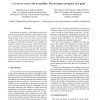RE
2009
Springer
14 years 7 months ago
2009
Springer
Increasingly complex supplier-relationships dominate product development, independent of industries and products. Mostly the primary source of risks and later problems is insuffic...
RE
2009
Springer
14 years 7 months ago
2009
Springer
Requirements traceability is a challenge for modern software projects where task dependencies and technical experspread across system developers, abstract model representations su...
RE
2009
Springer
14 years 7 months ago
2009
Springer
In the research of software reuse, feature models have been widely adopted to organize the requirements of a set of applications in a software domain. However, there still lacks a...
RE
2009
Springer
14 years 7 months ago
2009
Springer
RE
2009
Springer
14 years 7 months ago
2009
Springer
IT service requirements offer a seemingly classic Requirements Engineering (RE) problem. But, when attempting to solve it with RE methods, we are faced with difficulties. RE metho...
RE
2009
Springer
14 years 9 months ago
2009
Springer
Heterogeneously-licensed systems pose new challenges to analysts and system architects. Appropriate intellectual property rights must be available for the installed system, but wi...
RE
2009
Springer
14 years 9 months ago
2009
Springer
With the popularity of model-driven methodologies, and the abundance of modelling languages, a major question for a requirements engineer is: which language is suitable for modell...
RE
2009
Springer
14 years 9 months ago
2009
Springer
Service-oriented architectures (SOA) aim at the alignment of business and IT by having a clear business process-centric focus. In order to reach that goal, real-world business pro...
RE
2009
Springer
14 years 9 months ago
2009
Springer
Abstract—Security requirements often have implicit assumptions about trust relationships among actors. The more actors trust each other, the less stringent the security requireme...

